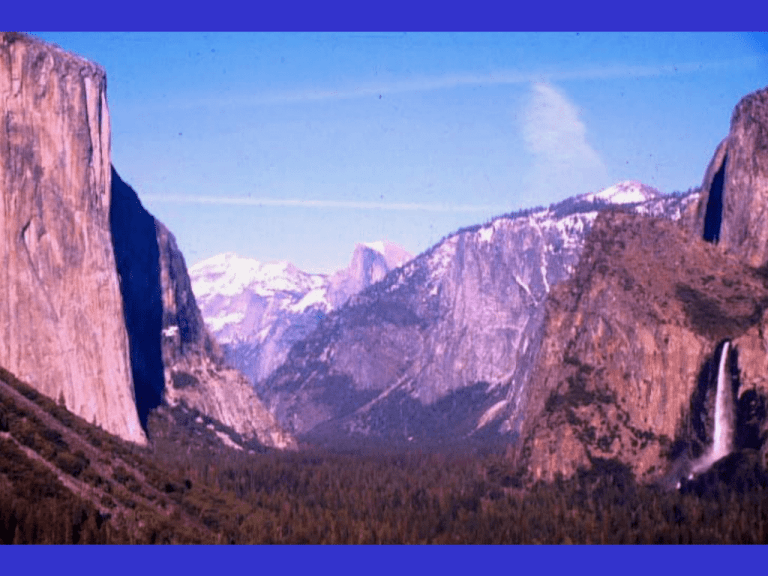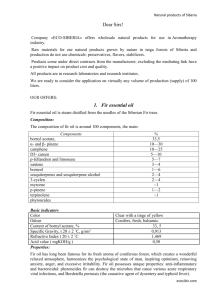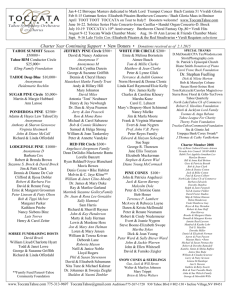Yosemite Talk
advertisement

Vegetation Types in Yosemite Valley Vegetation Type Mixed Conifer Meadow Riparian Black oak Live oak Other Hectares 950 147 208 98 410 128 % 49 8 11 5 21 6 Yosemite Valley 1899 Yosemite Valley 1961 1899 1961 1866 1961 Early to mid-1900s Tree felling for buildings, campgrounds, and bark beetle control Stump creation and subsequent infection by Heterobasidion annosum Ponderosa pine Incense cedar Yosemite Lodge complex 1972 cabin crushed by tree with rotted roots since 1973 7 fatalities 19 serious injuries Over $1M property damage Yosemite Lodge 1975 Root disease centers outlined Yosemite Lodge 1997 Root disease centers outlined Public safety Disturbance in Yosemite Valley Area surveyed Area in gaps Mean gap size 17.4 ha (~ 5 % of total area) 5.5 ha (31% of surveyed area) 2 1007 m 2 (81-12,500 m ) Number of Gaps 20 N = 70 Mean = 1007 m2 15 Median = 459 m2 10 Range = 81 - 8300 m2 5 0 Gap size (m2) Causal agent Heterobasidion annosum & bark beetles Mean area (m2) % of Gaps (range) 30.5 1342 (155-5075) Armillaria mellea & bark beetles 30.5 491(94-1425) Combination diseases (mostly H. annosum, A. mellea, or Phaeolus schweinitzii) 12.5 2147 (169-8325) 7 181(81-269) 12.5 728 (113-1688) 7 1629 (325-4500) Other diseases Bark beetles alone Other causes (fire, high water tables, etc.) Heterobasidion annosum gaps all started at a stump or stumps They may continue to expand for about 30 years Sentinel Beach Gap size = 4200 m2 10 meters Armillaria mellea infection center Infects all tree species Gap started at an infected black oak. Ponderosa Pine killed by western pine beetle, Dendroctonus brevicomis Heterobasidion annosum + Armillaria mellea gap Many gaps with very little regeneration and have not closed in Change in gap area 1972-1999 Year Area in gaps (m2) Percent in gaps 1972 6125 3.5 1999 53,981 31 El Capitan Picnic Area 1972 El Capitan Picnic Area 1997 Yosemite Valley as it used to be? Prescribed burn Yosemite Valley Opportunities for restoration? Pollution regulations Pollen records suggest that conifers may have dominated Yosemite Valley prior to the Miwok Lake Tahoe Basin Lake Tahoe Basin Old Growth Total coniferous forest = 48,620 ha 1998 area in old growth = ~2138 ha Percent in old growth = ~4 % Historic old growth area = 26,740 ha (estimated) Historic percent old growth = 55 % (estimated) Changes in forest composition over 150 yrs White fir and incense cedar have doubled in importance Jeffrey pine has declined by 50 % Lake Tahoe fires in the 20th Century No wildland fire > 800 ha has occurred since 1908 Between 1974 and 1996, there were only 9 fires > 4 ha Effective fire suppression and the high elevation environment (i.e., short fire season) have kept large fires to a minimum Stand Characteristics Lake Tahoe Seral Stems/ha 20 cm dbh 536 n=14 Old growth n=17 324 Sierra San Pedro Martir, Baja, Mexico Lake Tahoe Basin Lat. 39o 2000-2600 m elevation 50-100 cm annual ppt. Sierra San Pedro Martir, Baja Lat. 31o 2200-2900 m elevation 65 cm annual ppt. Tree Species Lower Montane Pinus jeffreyi, Abies concolor, Calocedrus decurrens, P. lambertiana Upper Montane Abies magnifica, A. concolor, Pinus contorta, P. monticola Subalpine Pinus albicaulis, P. contorta, P. monticola, Tsuga mertensiana, Abies magnifica, Fire Return Intervals Lake Tahoe and Baja Lake Tahoe 12-55 years SSPM 13-52 years Stand Characteristics Lake Tahoe and Baja Seral Stems/ha 20 cm dbh 536 n=14 Old growth 324 n=17 SSPM, Baja n=16 134 % stems in each DBH size class Distribution of live trees by size class 90 80 I = 20-50 cm; II = 50.1-100 cm; III > 100.1 cm n=5009 n=3718 70 60 n=1528 50 40 30 20 10 0 Seral Old growth SSPM Fir engraver beetle, Scolytus ventralis Heterobasidion annosum in fir stump Bark Beetles and Conifer Hosts Mountain pine beetle D. ponderosae sugar, lodgepole, western white pine Jeffrey pine beetle D. jeffreyi Jeffrey pine Fir engraver beetle Scolytus ventralis white fir, red fir Pathogens and Conifer Hosts Annosus root disease Heterobasidion annosum white fir, red fir Dwarf mistletoes Arceuthobium species white fir, red fir, Jeffrey pine True mistletoes Phoradendron species white fir, incense cedar White pine blister rust Cronartium ribicola sugar pine, western white pine, whitebark pine Mortality curves for mixed-conifer species # dead trees 600 500 400 Seral Old growth SSPM 300 200 100 0 60 64 68 72 76 80 84 88 92 96 Year Lake Tahoe Basin 1996 % stems in each DBH size class Distribution of dead trees by size class 90 I = 20-50 cm; II = 50.1-100 cm; III > 100.1 cm 80 70 60 50 40 30 20 10 0 Seral Old growth SSPM Changing role of pathogens and insects: Lake Tahoe: Pathogens and insects responsible for most mortality Baja: Pathogens and insects most important on older trees Fire mosst important om smaller trees Future Threats To California Forests Catastrophic fire Air pollution Urbanization Introduced pests Management Prescribed fire Thinning Sequoia National Park Annosus root disease in giant sequoia Conclusions • Human management of forests can change historical roles of pathogens and insects • These role changes and their consequences may not become apparent for decades • Current “restoration” activities (e.g., prescribed fire) generally do not take into account pathogens and insects • Returning forest to historical stand densities and processes will not necessarily return pathogens and insects to historical roles










